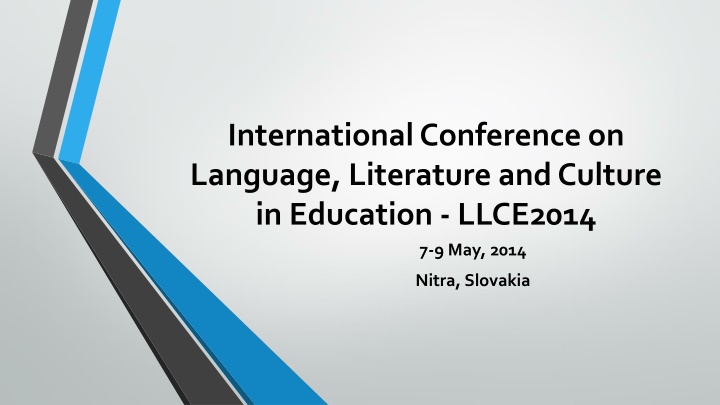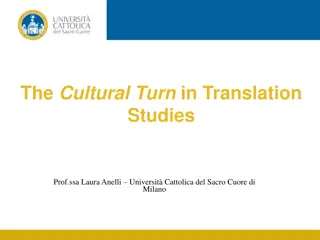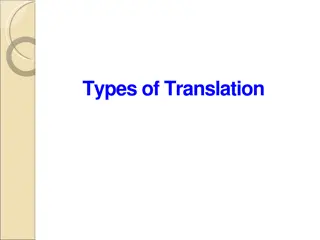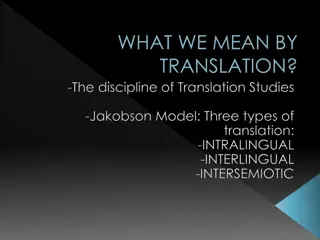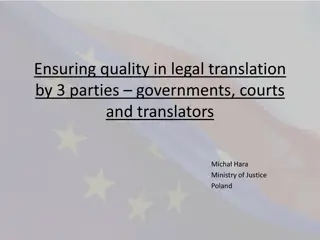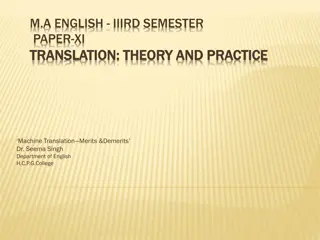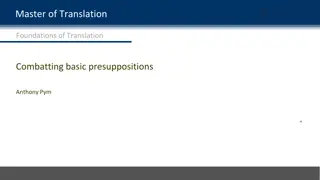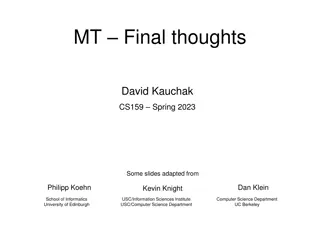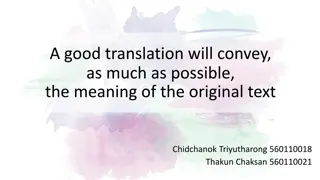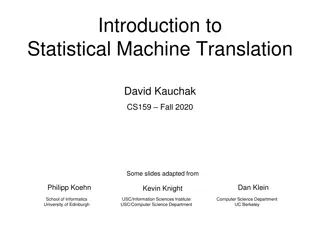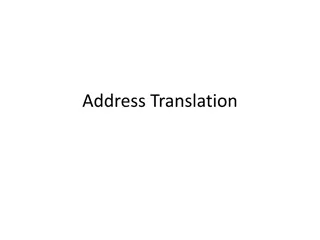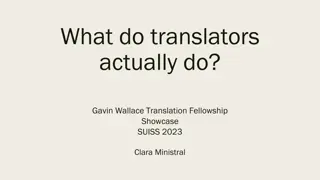Exploration of Translation and Culture in Education at LLCE Conference
Delve into the multifaceted world of translation as a psycho-linguistic activity and its profound impact on cultural dissemination and evolution. Unravel the intricate relationship between translation, linguistics, psychology, and cultural traditions, highlighting the transformative power of language bridging across civilizations.
Download Presentation

Please find below an Image/Link to download the presentation.
The content on the website is provided AS IS for your information and personal use only. It may not be sold, licensed, or shared on other websites without obtaining consent from the author.If you encounter any issues during the download, it is possible that the publisher has removed the file from their server.
You are allowed to download the files provided on this website for personal or commercial use, subject to the condition that they are used lawfully. All files are the property of their respective owners.
The content on the website is provided AS IS for your information and personal use only. It may not be sold, licensed, or shared on other websites without obtaining consent from the author.
E N D
Presentation Transcript
International Conference on Language, Literature and Culture in Education - LLCE2014 7-9 May, 2014 Nitra, Slovakia
Southeast European University, Tetovo, Macedonia www.seeu.edu.mk Kujtim Ramadani, PhD Candidate in Linguistics
What is translation? In theory, translation is a psycho-linguistic activity exercised either orally or in a written form for purposes of communication between communities or individualsthatdo notspeakthesamelanguage.
What is translation? Translationisnotabranchoflinguisticsanymore. Traductology(translatology):ascienceinitself. A science: close relationship with linguistics, psychology, lexicology and lexicography. A technique: relations with grammar, stylistics, and the art of writing. An art: esthetic acquisition of a linguistic reality (creation and re-creation:Shakespeare vs Fan Noli)
Translation and culture Translation does not reflect only the state of things in a given era, but rather can help in disseminating new models and styles established on various different linguisticand cultural structures, and caneven go thatfar as to impact the transformation and evolution of a completeculture.
Translation and culture Every civilization emerges from a single translation. (Folena, 1991) The notion of translation becomes very important in establishing newlinguistic and cultural traditions. (Folena, 1991) Horizontaland verticaltranslation: Horizontal: similar semantic, morphological and lexical structure, and culturallyclose Vertical: when the source language (usually Latin in the Middle Ages) becomes the model language (culture) for the target language (Folena 1991:13)
Translation and culture The act of translation, goes beyonda mechanical process or a mere transposition. Apart from facing with two different linguistic systems, it also causes a showdown betweentwodifferentcultures.
Translation and culture Cultural translation, which involves cultural differences. Cultural translation can also be defined as a practice whose aim is to present another culture via translation. This kind of translation solves some issues linked to culture, such as dialects,foodor architecture. translation represents the practice of
Translation of cultures A translator of cultures needs to deal with the issues between the source and the target language, that is to say he must respect at the same time the cultural source ofpointof viewandthetargetculture.
Translation of cultures Wilhelm von Humboldt shared this opinion of translation in a letter addressed to A.W.Schlegel, dated July 23, 1796: All translation seems to me simply an attempt to solve an impossible task. Every translator is doomed to be done in by one of two stumbling blocks: he will either stay too close to the original, at the cost of taste and the language of his nation, or he will adhere too closely to the characteristics peculiar to his nation, at the cost of the original. The medium between the two is not only difficult, but downright impossible.
Translation errors False friends (this notion in itself can be problematic to translate) Ambiguous words: Example: Flying planes can be dangerous. InterpretationA: Planesthat areflyingcanbedangerous. Interpretation B:Toflyplanescanbedangerous. Homophony: two&to,or saw&saw, etc.
What makes a good translator? Of course, in order to produce a genuine and almost perfect translation, one should have excellent knowledge of his/her mother tongue, of its expression tools and stylistics. A translator that has no good knowledge of his mother tongue, can not only deform the meaning of the translated text, but is at the same time a victim of his/her ownprofessionalism.
What makes a good translator? The translation specialization, by default, is chosen by those who have the propensity for languages and who know what their ultimate goal is. Valery Larbaud seems to have defined the ideal of a translator s specialist, when he says, A real translator has a combination of the rarest and the most precious human features: knowledge and patience, even clemency, sincerity and lucid mind, broadknowledge and a rich and skilful memory (Larbaud, 1981).
Conclusion The role of translator has always been important for purposes of successful communication among people. Umberto Eco, has justly pointed out that the craft of translation is a profession that belongs to the future ; modern world, regardless of how advanced it may get, will not be able to make it without translators. Therefore, this translators requires commitment, accountability. difficult task responsibility shouldered by and
